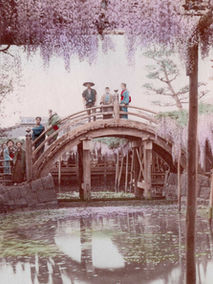An omoshirogara (novelty design) “Propaganda” nagajuban (under-kimono) featuring a hand-stencilled pattern composed of several elements such as roundels, rectangular postcards or pictures (?), overlapping objects, and smoke bands forming horizontal bands with nationalistic symbols. The design references contemporary Japanese achievements, including advancements in technology, the rise of tourism, and the upcoming 1940 Tokyo Olympics.
Inspired by Japan’s success at the 1932 Olympic Games in Los Angeles, where the country secured its first Olympic gold medals, and the selection of Tokyo as the host city for the 1940 Games, a national enthusiasm for sport emerged. During this period, many textiles with Olympic-themed imagery were produced in anticipation of the event. However, the substantial economic demands caused by the government's intensified mobilisation following the 1937 invasion of China led to Japan being stripped of its right to host the Games. Ultimately, the event was cancelled due to the outbreak of the Second World War (1939–1945), and the 1940 Tokyo Summer Olympics came to be known as the “Phantom Olympics”.
In the roundel marked “OLYMPIC”, two flagpoles can be seen bearing the Rising Sun war flag of the Imperial Japanese military, the national flag of the Empire of Japan, and the flag of Manchukuo (Japan's puppet state in Manchuria from 1932 to 1945). When worn, the bold pattern would have been largely concealed beneath the wearer’s outer kimono, with only a strip of the collar visible. These patterned undergarments, sometimes referred to as “hidden treasures”, are a remnant of the strict sumptuary laws of the Edo period (1603–1868), which restricted the public display of wealth and luxury. People found ways around these laws by lining the insides of their garments with luxurious, patterned silks, visible only to close friends and family. Following the abolition of such restrictions in the Meiji era (1868–1912), these textiles evolved into bold fashion statements.










